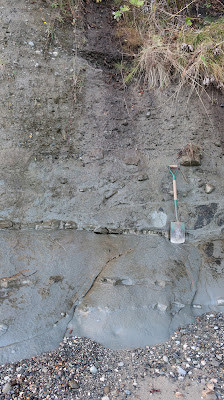The end of the road at Richardson on the southern shore of Lopez Island provides an easy to access view of part of the Lopez Structural Complex.
Richardson is named for the original land patent holder. He was granted the land shortly after the San Juan Island was determined to be part of the United States after a couple of decades of dispute between Great Britain and the United States regarding claims to the islands.
The community of Richardson grew as a commercial and fishing center in the late 1800s through the early 1900s. It was well positioned as a protected deep water port for transporting farm products off the island and bringing goods to the island. A cannery for the fishing industry was located at the bay shore to process salmon that were netted via net traps set along the south shore of the island. Over time agricultural changes, fishing changes and the location of the ferry on the north side of the island led to the commercial development fading away. For a time a store at the end of the road was a destination for visitors - I once ate a large ice cream cone after a bike ride to the south end of the island. The abandoned dock and bulk fuel facility remain, but the store is gone.
Former bulk fuel storage tanks
Old dock with Olympic Range in the distance across the Strait of Juan de Fuca.
The road end at the old bulk fuel facility provides easy access to views of a portion of the Lopez Structural Complex (LSC). This location is discussed in
Brandon (1989),
Brown and others (2005) and
Brown, Housen and Schermer (2007). Relative to other parts of the LSC this area appears somewhat coherent; however, this site has some highly deformed and fault bound units as well.
Just below the end of the road along the shore are great exposures of pillow basalt.
Pillow basalt. Note sheared zone at base of pillows in picture
This basalt is an ocean floor basalt. The pillow structures are hardly disturbed at all despite having been once deep within a subduction zone trench more than 20 kms below the surface.
A short distance away the pillows are deformed.
Stretched and deformed pillows
At the road cut above the shore a contact between greenish metamorphosed volcanic rocks and maroon mudstones is a good example of why the Lopez Structural Complex is called a complex.
Analysis of micro fossils in the mudstone suggest an age of 112-115 Ma (million years) (Brown and others, 2005). The mudstone and the contacts along the mudstone appear to be highly sheared.
Shearing within the LSC often appears to be more intense as tectonic stress and fault movement may preferentially take place within weaker rock units. Brown and others (2005) also dated metamorphic minerals in the pillow basalt and found metamorphism of the basalt took place at 124 Ma. Hence, the pillow basalt is older and was deep in the subduction trench when the mudstone was formed. The mudstone was not deposited on the basalt, but the two units were faulted so that they are now abutted with one another.
This finding has implications for trying to piece together the assemblage of accreted terranes that make up northwest Washington - a very tough puzzle that has led to very different interpretations.
The complexity of the LSC and the context of the LSC within the accreted terranes of northwest Washington and western North America is a lot to take in. Besides getting a little perspective of tectonic geology it is simply nice to see well exposed bedrock and structures in western Washington.
I liked this small exposure as it captures an observation Brandon made about trying to decipher tectonic deformation from soft sediment deformation.
Behind the mail box it is clear these rocks have undergone multiple deformation events.
Tight small fold adjacent to shear surface
Pillow basalt being made unrecognizable
Highly sheared volcanic breccia







































